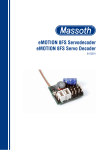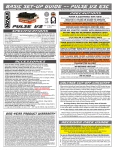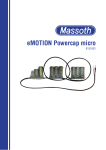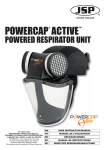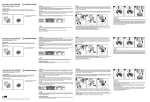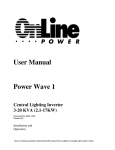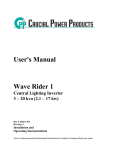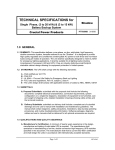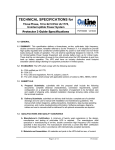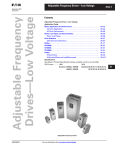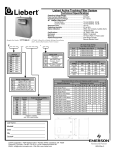Download Installation manual for Powercaps
Transcript
Installation manual for Powercaps A. Upon reception of the Powercap 1- Inspect the Powercap for any damage that may have occurred during transportation. Check the enclosure for any dent or bent brackets. 2- Open the Powercap and check the construction for any loose wire or nuts. Check capacitor cells integrity (bent or dented cover). 3- If any damage is found, file a claim against the transportation company and notify Power Survey for RMA procedure. Do not use damaged Powercap or compromised cells. _____________________________________________________________________________________________ B. Mounting Information 3- Do not install immediately near heat source like oven, 1- Unless you ordered a NEMA 3R Powercap, your Powercap is designed for indoor use (NEMA 1). furnace and the like. 2- Powercap comes with mounting brackets and are designed for mounting on walls. When you are installing a Powercap you must make sure that you leave minimum ventilation clearance recommended by Power Survey (see image on right). All adjacent equipment or others obstruction shall be considered as walls or overhead. No more than three barrier, including the floor or overhead shall restrict free circulation of air. _____________________________________________________________________________________________ C. Operating / Storage temperature and environment variables Temperature need to be taken into account when you store or operate a Powercap. a. b. Storage temperature is the temperature of the immediate area around the Powercap before it is installed or when it is not operating. c. Operating temperature is the temperature of the immediate area when the Powercap is energized. Use the following procedure to determine operating temperature: 1- The Powercap must have been in operation for the last 24 hours before temperature is measured 2- The operating temperature must be determined by taking the average of three readings taken as follow (all 12 inches from the Powercap): One thermometer level with top of the Powercap. One thermometer 12 inches above bottom of Powercap. One thermometer midway between the two precedent positions. Operating temperature: -40 F to +115 F, with natural convection cooling Storage temperature: -40 F to +185 F Maximum altitude: 2000 Meters above sea level Humidity: 0 – 95% non-condensing _____________________________________________________________________________________________ _____________________________________________________________________________________________ D. Installation Before installing: Make sure that the Powercap nameplate voltage rating is suitable for operations at the supply line voltage. Capacitors are capable of operation at a maximum of 110 percent of nameplate rated voltage (RMS, 60 Hz, including harmonics, but exclusives of transients). The installation of capacitors is regulated in the National Electrical Code, article 460. Power Survey meets all the requirements of the Code relative to discharge resistors and over current protection. Preferred connections for the terminal capacitors are illustrated below: Install at position 1 Position one being considered the ideal location. Note that when the capacitor is placed between the motor running over current protection (motor overload relay heater coil) and the motor, less current will flow through the overload relay and the motor running over current heater coil will have to be changed to compensate for the reduced current to the motor due to the addition of the capacitor. Install at position 2 Position two between the starter and thermal overload is the second best choice on existing motor applications when overload rating is higher than permitted by the NEC code. 3) The motor is subject to repetitive switching, jogging, inching or plugging 4) A multi-speed motor is used 5) A reversing motor is used 6) A high-inertia load may drive the motor In any of theses cases the capacitors should be switched with a contactor interlocked with the motor starter (see position 3). Installation directly on the power line Powercap which are going to be installed for line correction must be provided with conductors that are rated at a minimum of 135% of the rated capacitor current (NEC Section 460.8, see cable size table). Also, over current protection and disconnects (165% current) or circuit breakers (150% rated current, which are manufacturers minimum recommended derated sizes). Use wire size as recommended on the wired size table. Power leads inside a capacitor case should be as straight as possible and without kinks or loops. Lead length should be such that no strain is applied to the power lead connector. Power leads shall be firmly clamped in connectors by tightening connector bolts. Wire lead strands should not move in connector when the lead is moved from side to side by hand. Loose connections will cause terminal overheating and possible early failure of capacitor unit. Overall view of the capacitor on the line Preferred connections for Powercaps Install at position 3 As per IEEE standard, never connect the capacitor directly to the motor when: The Powercap must be connected to any location through a disconnect device and have over current protection. All customers wiring must be protected as it passed through the capacitor case with a cable or conduit connector or insulating grommet. Grounding 1) Solid state starters are used All capacitors are provided with ground connector lugs in 2) Open-transition starting us used to facilitate grounding as per NEC Article 250. _____________________________________________________________________________________________ _____________________________________________________________________________________________ E. Capacitor and Fuses The following are the principal characteristics of our capacitor cells: 1. Power Survey capacitor come in two forms, dry type and oil type. Oil type fluid is non-PCB, non-toxic biodegradable fluid. 2. The dielectric system consists of self healing, metallized Polypropylene. 3. Capacitors tolerance is between 0% and 15%. 4. Over current tolerance is 135% rated current continuous, include harmonic currents (150% for high harmonics cells). 5. Over voltage is 110% rated voltage continuous (120% for high harmonic cells). 6. Each cell has a built-in interrupter device to remove the capacitor from the line before internal pressures can cause the case to rupture. Threshold is 10 kA. Power Survey capacitors are furnished with correctly sized fuses with interrupting ratings of 100 KAIC or 200 KAIC. Current ratings of fuses have been selected so that the fuses will handle normal inrush current and protect major internal fault conditions. It is not recommended to substituting fuses with different ratings than the factory installed fuses. _____________________________________________________________________________________________ F. Inspection and maintenance Installation inspection should be made within 8 to 24 hours after capacitors have been energized and during the first period of maximum over voltage which will occur when your power system is lightly loaded. NEVER manipulate a capacitor that has juste been switched off since they remain energized. The capacitors are equipped with a discharge resistance (330 kOHM for Aerovox capacitors) that will de-energize these in approximately 1 minute (600v or less). ALWAYS take the following precautions before manipulating the capacitors: a. b. Wait 1 minute before touching the terminals of the capacitor. Use a voltmeter to measure the voltage between the terminals. If the capacitors are not completely deenergized leave the voltmeter connected to the terminal until the reading shows no voltage. (The voltmeter’s internal resistance will help discharge the capacitor). Measuring capacitor integrity In order to determine capacitor integrity, measure of voltage and current on each phase should be taken to determine that: 1) Phase voltages are balanced and below the maximum voltage rating of the capacitor 2) Phase current are balanced 3) Operating current does not exceed 135% of the rated value of the unit or assembly. Do not exceed 135% of rated KVAR current This kVAR current shall include: 1- Current due to excess voltage above the nameplate voltage rating at fundamental frequency, but applied Voltage shall not exceed 110 percent of nameplate voltage. 2- Current due to other frequency or harmonic voltage superimposed on the fundamental frequency 3- Current in excess of the nameplate rating due to manufacturing tolerances. Manufacturing tolerances permit a KVAR variation of +15%, -0% over nameplate. _____________________________________________________________________________________________ G. Service If you PowerCap is equipped with blown fuse lights, the light will glow when the fuse blows (unless your model comprise the ON sigils which mean that light will be OFF if fuse is blown). Before replacing fuse, make sure the capacitor is not shorted. Most frequent cause of capacitor outage is a blown fuse caused by misapplication, resulting in over current. The fuse may be replaced. To verify is the capacitor is functioning properly measure each phase with an ammeter and compare the measured current with table X at the end of this document. Phase current must be balanced. If any abnormal reading is noted, turn off power and wait one minute then short between all terminals to be certain the capacitor has discharged completely. Using a simple ohmmeter you may now check each cell for charging current. Measure ohms between all three phases on the capacitor terminals (not the fuses). If the ohmmeter then read zero, the capacitor is shorted and must be replaced. If the meter indicate zero and then and then shows normal data the capacitor is probably good. If blown fuses have been observed, they should be replaced with the same value. If blown fuses happen frequently, assemble information on current installation topology (single line drawing for example), motor descriptive nameplate and so on and consult factory. _____________________________________________________________________________________________ _____________________________________________________________________________________________



